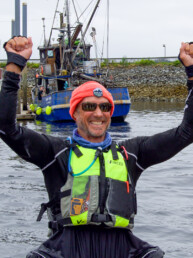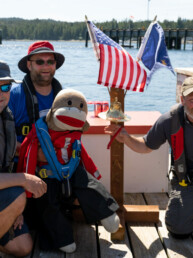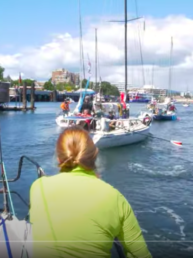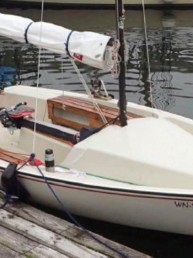Team Wild Card has been hard at work since buying our ride for the 2018 Race to Alaska. The boat is a Santa Cruz 27, hull number 55. She was considered ahead of her time in the 70s, but time has not been kind to hull 55 in recent years.
When we found her on Craigslist, a partial restoration had begun on the inside, but the decks had soft spots. Cored with balsa, she is light, but over time water had intruded and a quick inspection showed that a portion of the decks would have to be replaced. A “portion” turned out to be wildly optimistic.
So, yeah, we knew the decks needed work when we bought her. We knew about the bent spreaders, bent spinnaker pole and really old sails. We only found the wasps nests down below later. The price we paid was roughly equivalent to the cost of the trailer and a few recently installed electronics. The boat itself was virtually “free.” A free boat. There are two-word combinations that carry far more drama than just two words should. “Unintended Consequences.” “Nuclear Fallout.” “Collateral Damage.” And I’d now submit that “Free Boat” ranks right up there.

Last July while most of the R2AK fleet was still navigating the Inside Passage, we trailered the boat from cow pasture land in central Oregon to the thriving metropolis of Skykomish, Washington — population 198 — which is an odd geographic island of King County not directly accessible to the rest of the county by road.
Skykomish is home for Mike, one of our four man crew. Mike and his wife have a shop on their property with a raised floor owing to the nearby flood plain. After a few chainsaw modifications, the boat slipped neatly into the shop where those soft “portions” of deck would sit at waist level and comfortably near his wood burning stove. It seemed to be perfect solution, or so I thought, back in September. We could launch in late February. There’s plenty of time!

We started with the “thump” test on the decks to identify the soft spots. Easy. Mark the area with a Sharpie, cut out the skin, remove the damaged coring, and replace it. So we cut into the deck and predictably discovered the rotted coring. But in the process of removing it, we’d soon discover that the adjacent balsa coring was wringing wet. It passed the test, hadn’t yet rotted, but would soon be well on its way. We cut that out, too.

At some point during the early work sessions of cutting out coring, mixing resins, and replacing the cleared sections, we came to the conclusion that the decks, nearly in their entirety, were toast. There was a portion of the deck that still was good. But it was a very small portion. We ended up replacing about 90 percent of the decks from the bow to the length of the side decks as well as the cabin top.
From a structural standpoint, elephants can now dance on the decks. Replacing the core was, for me, a very satisfying process. I learned a lot, which was a large part of the problem. While the four of us have a diverse array of skills, each of us had challenges when it came to doing the actual work.
Andy had sequestered himself up in Seward, Alaska, effectively insulating himself from our work sessions, as the Seward-to-Skykomish commute has proved too long. Robby is the engineer who attacked wiring, rigging and winch rebuilding. Great at all that, but had never done deck work. I was the procurer, getting all the supplies, scoring a pedal drive, ordering the rigging and electronics, and I organized our race entry paperwork. I was, as described by R2AK Race Boss Daniel Evans, the “lead bureaucrat.” While I, like the others, have sailed all my life, my boat restoration skills were lacking. Hell, non-existent (but I have been learning a lot).
It is Mike who’s the craftsman. Raised in Maryland, he hung around boatyards as a kid and still does as a grown kid. Most of his 40 something years have either been spent on some adventure or building things. Accordingly, the guy can solve problems. He had replaced portions of the deck on his own boat and has done fiberglass work before. And, quite clearly, he’s the type of guy that reads up on current techniques to augment his considerable experience.

I shudder to think about where the project would be without Mike. I was merely the ambulance driver, getting the boat to Mike’s shop. Mike has been the surgeon, carefully operating on the patient to bring the boat back to life.
As I write this, the decks have been rebuilt. The fairing and sanding, those endless processes to ensure a smooth deck, are still ongoing. Scrapping out the rotten core, replacing it and glassing it in are transformational and immensely satisfying. Sanding and fairing and sanding and fairing and sanding and fairing to get the decks to that perfect shape are incremental processes that frustrate me. But they require a keen eye, patience and skill. Again, have I mentioned Mike?

Robby has all the winches apart and sourced spares. Yes, these were 70’s era Barient winches and Barient itself has gone the way of maritime equipment extinction with only two sources on the planet for parts. Robby found both sources and five of the six winches are likely to survive. One remains frozen, currently immersed in lubricant. The prognosis is uncertain.

This past weekend Robby ran wires for the autopilot, installed the VHF radio, sited our AIS, and tested all the breakers. Given the simplicity of our requirements (no refrigeration, no real systems) he hopes to be substantially done next week. Solar is a big TBD, but we’re going to wait until after the deck configuration is sorted out.
Our bent spreaders have been fabricated and the rigging should be done next week.
Our sails have been ordered.
Our bunks are being refurbished.
What little woodwork there is has 3 coats of varnish – 3 more are coming.
The head (yeah, we’re going to have one) needs to be installed.
Next weekend we hope to have her paint ready.
And the list goes on. But we’re getting there.
Oh how I remember that “plenty of time” thought back in September. Now we’re in a race before the race. The race against time.
We hope to rig the boat and get the sails by mid to late April. Given the lead time for the sails, that’ll give us a month of sailing with the old sails before the race and another month with the new sails. Plenty of time. Right?
I’ve been at the start of each of the past three races R2AKs. During the first race I was especially astounded at the fundamental things being worked out by teams just hours before the gun. I figured someday I’d do the race to reprise my own trip to Ketchikan in a leaky old wooden Dragon Class sailboat, and I vowed then to not be that last minute person. I don’t think we will be because, we have, I keep reminding my delusional self, plenty of time….
Follow Team Wild Card on Facebook and find out more about the Race to Alaska…
Team Wild Card is proud to partner with these fine sponsors:












